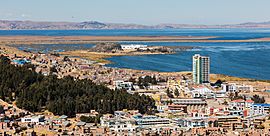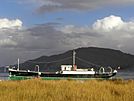Puno facts for kids
Quick facts for kids
Puno
San Carlos de Puno
|
|||
|---|---|---|---|
|
Puno and the Titicaca, Historical ship Yavari, Titicaca lake, Floating islands of Uros and Puno Cathedral
|
|||
|
|||
| Nickname(s):
Ciudad del Lago
(City of the lake) |
|||
| Country | Peru | ||
| Region | Puno | ||
| Province | Puno | ||
| Founded | November 4, 1668 | ||
| Area | |||
| • Total | 20.28 km2 (7.83 sq mi) | ||
| Elevation | 3,830 m (12,556 ft) | ||
| Population
(2017)
|
|||
| • Total | 128,637 | ||
| • Estimate
(2015)
|
140,839 | ||
| • Density | 6,343.0/km2 (16,428/sq mi) | ||
| Time zone | UTC-5 | ||
| Area code(s) | 51 | ||
| Website | [1] | ||
Puno is a city in southeastern Peru. It sits right on the shore of Lake Titicaca. Puno is the capital city of the Puno Region and the Puno Province. About 140,839 people lived there in 2015.
The city was started in 1668 by a leader named Pedro Antonio Fernández de Castro. It was first called San Juan Bautista de Puno. Later, its name changed to San Carlos de Puno. This was to honor King Charles II of Spain. Puno has many old churches from the time of Spanish rule. These churches were built for the Spanish people and to teach the Quechua people about Christianity.
About Puno
Puno is a key area for farming and raising animals. Important animals raised here are llamas and alpacas. They eat grass on the huge flat lands called plateaus and plains. The city's economy also gets a boost from goods brought in from Bolivia. Puno has an airport nearby called Inca Manco Capac International Airport in Juliaca.
Puno is located between the shores of Lake Titicaca and the mountains. There isn't much flat land between the lake and the hills. Because of this, the city has grown upwards onto the hillsides. The parts of town higher up on the hills often have very steep streets. These streets are usually not paved and cars cannot drive on them easily.
One of these steep streets leads to the Kuntur Wasi viewpoint. Here, you can find a large metal statue of a condor. You have to climb about 700 steps to reach this statue.
Puno is famous for its "Virgen de la Candelaria" festival. It also hosts a competition for traditional dances. The city is close to 41 floating islands on Lake Titicaca. The Uros people still live on these islands today. They built the islands themselves and depend on the lake for everything. These islands are a big draw for tourists. Dragon boat racing is also a popular activity for visitors. It is an old tradition in Puno.
Puno is a major stop for people moving from the Andes mountains to bigger cities in Peru. It is the largest city in the southern Altiplano region. Many people come here from smaller farming towns. They hope to find better chances for school and jobs. Puno has several small schools for technology and other skills. It is also home to the Universidad Nacional del Altiplano de Puno (UNAP), which opened in 1856.
Puno's Weather
Puno has a subtropical highland climate. This means it's usually cool, but not too cold, and it gets a lot of sun.
Because Puno is very high up, it has more extreme weather than you might expect. The average temperature each year is about 8.4 °C (47.1 °F). It never gets very hot. In the winter months, from June to August, temperatures at night often drop below 0 °C (32 °F). The sun's rays are very strong at this high altitude. Most of the rain falls during the summer months in the southern hemisphere. The winter months are very dry.
| Climate data for Puno, elevation 3,825 m (12,549 ft), (1991–2020) | |||||||||||||
|---|---|---|---|---|---|---|---|---|---|---|---|---|---|
| Month | Jan | Feb | Mar | Apr | May | Jun | Jul | Aug | Sep | Oct | Nov | Dec | Year |
| Mean daily maximum °C (°F) | 16.0 (60.8) |
15.7 (60.3) |
15.6 (60.1) |
15.7 (60.3) |
15.5 (59.9) |
14.8 (58.6) |
14.9 (58.8) |
15.7 (60.3) |
16.6 (61.9) |
17.2 (63.0) |
17.7 (63.9) |
17.2 (63.0) |
16.0 (60.9) |
| Daily mean °C (°F) | 11.0 (51.8) |
10.8 (51.4) |
10.6 (51.1) |
9.9 (49.8) |
8.4 (47.1) |
7.2 (45.0) |
7.1 (44.8) |
8.1 (46.6) |
9.5 (49.1) |
10.0 (50.0) |
11.2 (52.2) |
11.4 (52.5) |
9.6 (49.3) |
| Mean daily minimum °C (°F) | 5.9 (42.6) |
5.9 (42.6) |
5.5 (41.9) |
4.0 (39.2) |
1.2 (34.2) |
−0.5 (31.1) |
−0.8 (30.6) |
0.4 (32.7) |
2.3 (36.1) |
3.8 (38.8) |
4.7 (40.5) |
5.6 (42.1) |
3.2 (37.7) |
| Average precipitation mm (inches) | 158.7 (6.25) |
144.9 (5.70) |
116.3 (4.58) |
50.8 (2.00) |
7.2 (0.28) |
3.0 (0.12) |
3.4 (0.13) |
9.6 (0.38) |
23.5 (0.93) |
44.1 (1.74) |
40.0 (1.57) |
87.6 (3.45) |
689.1 (27.13) |
| Source: National Meteorology and Hydrology Service of Peru | |||||||||||||
Puno's Folklore and Traditions
Music and dance are a big part of Puno's traditions. Some of the most important dances are:
- Wifala de Asillo
- Ichu Carnival
- Tuntuna
- Khashua de Capachica
- Machu-tusuj
- Kcajelo
- Pandilla Puneña
Images for kids
Gallery
-
Lake Titicaca as seen from the shore.
See also
 In Spanish: Puno para niños
In Spanish: Puno para niños

















